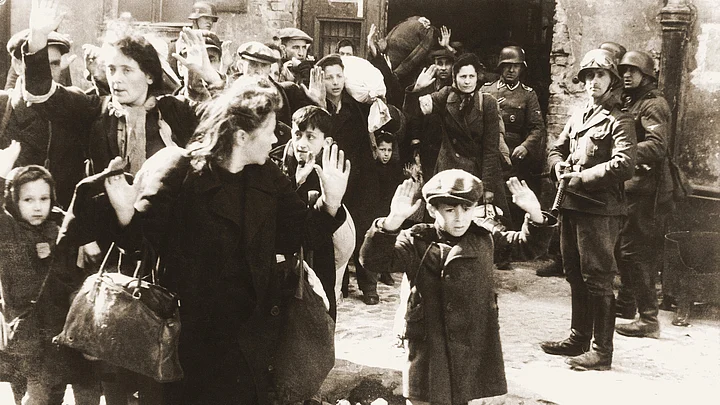(On July 22, 1942, deportations had began from the Warsaw ghetto to the new extermination camp, Treblinka. The Quint is re-publishing an article from its archives, as we revisit the horror of the gas chambers the Jews were put through by the Nazi forces. This article was first published on July 23, 2015.)
Long before Auschwitz (Oswiecim in Polish) became the Nazis’ efficient machine for the annihilation of Europe’s Jews, Treblinka had become the largest extermination camp operated by the murderous SS, led by Heinrich Himmler and his deputy Reinhard Heydrich.
On 20 January, 1942, a decision was made to expand Treblinka, which was only a slave labour camp until then, to fulfill the Nazis’ ‘Final Solution’ objective. By mid-May 1942, the gas chambers were in place.
And 74 years ago today, concealed in the cover of thick woods on the Warsaw-Bialystok rail route, the first set of Jews from the Warsaw ghetto, were exterminated.
While watching Warsaw Ghetto: The Unfinished Film, made by the Nazis who meticulously documented their own evil, it struck me that the central idea was to project the contrasting pictures of what went on in the walled, run-down, filthy and over-crowded ghetto of half-a-million doomed Jews – the affluence and the dire poverty, which itself was the result of the Nazis’ policy to warehouse Poland’s Jewry. Several hundred ghettos were established across the General Gouvernement of Poland with Lodz, Lublin, Krakow, Piotrkow, Tarnow and Bedzin among the worst.
Historians are of the considered opinion that by the winter of 1942, Treblinka, Belzec, Sobibor and the much smaller death camp at Majdanek – the four extermination centres part of Operation Reinhard, named in honour of Heydrich after his assassination in Czechoslovakia – had accounted for the systematic killing of nearly 1.3 million Jews. The Treblinka gas chambers, operated by diesel fumes from captured Russian tanks (Zyklon B had not been thought of then), alone killed 713,555 people. Nearly 400,000 of these belonged to the Warsaw ghetto. Within two months, around 254,000 Warsaw ghetto and 112,000 Jews from other places in the Warsaw district had been gassed at Treblinka.
The death camp at Treblinka, about 100 kilometres north-east of Warsaw, was operated by just about 100 SS guards, including some Ukrainians and Polish hiwis, besides Jewish Sonderkommandos. It was not a great distance by train, but for the Jews packed in wagons it took an eternity. And when they reached the camp, there was the usual process: men, women and children marched in separate files before each group was led into designated areas where they were ordered to strip. They then stepped into the windowless chambers with thick steel doors lined with rubber. From here, they never stepped out.
According to historian Laurence Rees, the extermination camps at Treblinka, Sobibor and Belzec have “scarcely seeped into the popular consciousness” and that “these camps are not mentioned today in the same breath as Auschwitz is something of a black irony, because the Nazis themselves wanted their names erased…once they had completed their murderous task.”
Almost a year after the August 1943 uprising of the Jewish Sonderkommandos, who performed the inhuman job of taking the captives into the gas chambers and then burning the bodies in the crematoria, Treblinka remained in operation. It was abandoned as the Soviet Red army advanced towards Berlin. When the remainder of the Warsaw ghettos Jews rose up in arms in April 1943, the Nazis liquidated them mercilessly, blowing the buildings with tanks and machine-gunning the occupants. Only 70 Jews from the ghetto survived.
Drawing a Stark Parallel
The “black irony” of 1943 may be reflected in Israel’s handling of the Gaza strip which is no less a horror than the Warsaw ghetto. In 2014, writing in the Haaretz, Amir Nizar Zuabi said: “Upper Gaza is totally abandoned. All of Gaza has moved underground. Men, women and children, a great mass of people.”
Since 2000, Gaza became a “sunnier” Warsaw ghetto. There thrives a black market just as it did in the Polish town more than 76 years ago. Israel controls the imports to strip of land where underground tunnels to Egypt form the lifeline.
Sure, Israel has not documented the Palestinians in Gaza and they have not been exterminated. But residents of Gaza have often faced bombs and rockets that have maimed men, women and children. And ironically, it was in July 2014 that the 1.8 million besieged people of Gaza strip were bombed, shelled and attacked by a vastly superior and brutal Israeli Defence Forces.
Suffering, whether in the Warsaw ghetto or in Gaza strip, transcends space, time and religion. The parallels between then and now could not be less stark.
